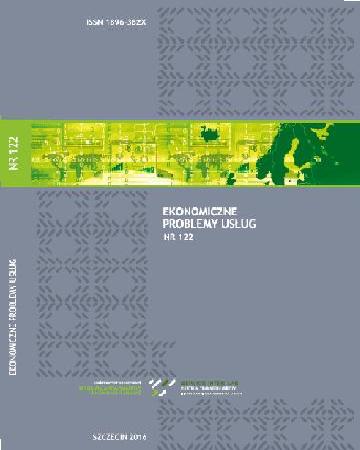
ISSN: 1896-382X
eISSN: 2353-2866
OAI
DOI: 10.18276/epu.2017.126/2-20



Issue archive /
nr 126 (2) 2017
The issue of digital divide in rural areas of the European Union
| Authors: |
Joanna
Kos-Łabędowicz
University of Economics in Katowice Faculty of Economics Department of International Economic Relations |
| Keywords: | digital divide rural areas digital convergence the European Union |
| Data publikacji całości: | 2017 |
| Page range: | 10 (195-204) |
| Klasyfikacja JEL: | D63 L86 L96 |
Abstract
The increasingly popular use of ICT in different areas of life results in changes of the situations of individuals and entities. However, along with the new possibilities of socioeconomic development, come new risks related to the rise of a new type of inequalities. One of such threats is the digital divide or - in other words - the lack of equal access to the opportunities offered by the Internet and other ICT. The phenomenon of the digital divide applies to both individuals and areas or even countries. The aim of this paper is to introduce the digital divide and the factors influencing the lack of digital convergence with particular emphasis on rural areas of the European Union. In EU's rural areas there is an additional hindrance to achieving digital convergence similar to the urban areas - that is the aging of the population and the progressive depopulation of the countryside.
Download file
Article file
Bibliography
| 1. | Batorski, D., Płoszaj, A, Jasiewicz, J., Czerniawska, D., Peszat, K. (2012). Diagnoza i rekomen¬dacje w obszarze kompetencji cyfrowych społeczeństwa i przeciwdziałania wykluczeniu cyfrowemu w kontekście zaprogramowania wsparcia w latach 2014-2020. Warszawa: |
| 2. | Ministerstwo Rozwoju Regionalnego. |
| 3. | Bednarczyk, D. (2014). Przeciwdziałanie cyfrowemu wykluczeniu Ce-integracja) w Polsce. Biule¬tyn EBIB, Gromadzenie i zabezpieczanie danych cyfrowych, 9 (154). |
| 4. | Dijk, J. van (2010). Społeczne aspekty nowych mediów. Warszawa: Wydawnictwo Naukowe PWN. |
| 5. | Doong, S.H., Ho, S. (2012). The impact of ICT development on the global digital divide. Elec¬tronic Commerce Research and Applications, li (5), 518-533. DOI:l0.1016/ j.elerap.2012.02.002. |
| 6. | European Commission (2010). Digital agenda for Europe 2010-2020: Communication from the Commission to the European Parliament, the Council, the European Economic and Social Committee and the Committee of the Regions. Luxembourg: EUR-OP. |
| 7. | Goldfarb, A, Prince, J. (2008). Internet adoption and usage patterns are different: Implications for the digital divide. Information Economics and Policy, 20 (1), 2-15. DOI:l0.1016/ j.infoecopol.2007.05.001. |
| 8. | Grimes, S. (2000). Rural areas in the information society: diminishing distance or increasing learning capacity? Journal of Rural Studies, 16 (1), 13-21. DOI:l0.1016/s0743- 0167(99)00027-3. |
| 9. | ITU (2016). JCT Development Index 2016. Retrived from: http://www.itu.int/net4/ITU¬D/idi/2016/ (28.12.2016). |
| 10. | James, J. (2009). Information technology use among individuals in rich and poor countries: The disappearing divide. Telematics and Informatics, 26 (4), 317-321. DOI:l0.1016/ j.tele.2009.03 .002. |
| 11. | Jastrzębska, A, Jastrzębska, W. (2012). Wykluczenie cyfrowe - przyczyny, zagrożenia i bariery jego pokonania. Studium przypadku. W: Nierówności społeczne a wzrost gospodarczy. Modernizacja dla spójności społeczno-ekonomicznej w czasach kryzysu, issue 25 (p. 91- 104). Rzeszów: Uniwersytet Rzeszowski. |
| 12. | Malecki, E.J. (2003). Digital development in rural areas: potentials and pitfalls. Journal of Rural Studies, 19 (2), 201-214. DOI:l0.1016/s0743-0167(02)00068-2. |
| 13. | Mitzner, T.L., Boron, J.B., Fausset, C.B., Adams, AE., Charness, N., Czaja, S.J., Sharit, J. (2010). Older adults talk technology: Technology usage and attitudes. Computers in Hu¬man Behavior, 26 (6), 1710-1721. DOI:l0.1016/j.chb.2010.06.020. |
| 14. | Nishida, T., Pick, J.B., Sarkar, A. (2014). Japan's prefectural digital divide: A multivariate and spatial analysis. Telecommunications Policy, 38 (11), 992-1010. DOI:l0.1016/j .telpol.2014.05.004. |
| 15. | Park, S. (2016). Digital inequalities in rural Australia: A double jeopardy of remoteness and social exclusion. Journal o/Rural Studies, I. DOI:l0.1016/j.jrurstud.2015.12.018. |
| 16. | Park, S.R., Choi, D.Y. i Hong, P. (2015). Club convergence and factors of digital divide across |
| 17. | countries. Technological Forecasting and Social Change, 96, 92-100. |
| 18. | DOI: 10.1016/j.techfore.2015.02.011. |
| 19. | Pick, J.B., Nishida, T. (2015). Digital divides in the world and its regions: A spatial and multivar¬iate analysis of technological utilization. Technological Forecasting and Social Change, 91, 1-17. DOI:l0.1016/j.techfore.2013.12.026. |
| 20. | Pick, J.B., Sarkar, A., Johnson, J. (2015). United States digital divide: State level analysis of spatial clustering and multivariate determinants of ICT utilization. Socio-Economic Plan¬ning Sciences, 49, 16-32. DOI: 10.1016/j.seps.2014.09.001. |
| 21. | Preston, P., Cawley, A., Metykova, M. (2007). Broadband and rural areas in the EU: From tech-nology to applications and use. Telecommunications Policy, 31 (6-7), 389-400. DOI: 10.1016/j.telpol.2007.04.003. |
| 22. | Rowe, B. (2003). Rural technology deployment and access: successes upon which to build. Gov-ernment Information Quarterly, 20 (2), 85-93. DOI:l0.1016/s0740-624x(03)00034-0. |
| 23. | Selwyn, N. (2006). Digital division or digital decision? A study of non-users and low-users of computers. Poetics, 34 (4-5), 273-292. DOI:l0.1016/j.poetic.2006.05.003. |
| 24. | Vicente, M.R., López, A.J. (2011). Assessing the regional digital divide across the European Union-27. Telecommunications Policy, 35 (3), 220-237. DOI: 10.1016/j.telpol.2010.12.013. |
| 25. | Warren, M. (2007). The digital vicious cycle: Links between social disadvantage and digital exclusion in rural areas. Telecommunications Policy, 31 (6-7), 374-388. DOI:l0.1016/ j.telpol.2007.04.001. |
| 26. | Weforum (2016). Global Information Technology Report 2016. Retrived from: http://reports.weforum.org/global-information-technology-report-2016/ (28.12.2016). |
| 27. | Zhang, X. (2013). Income disparity and digital divide: The Internet Consumption Model and cross-country empirical research. Telecommunications Policy, 37 (6-7), 515-529. DOI: 10.1016/j.telpol.2012.12.011. |